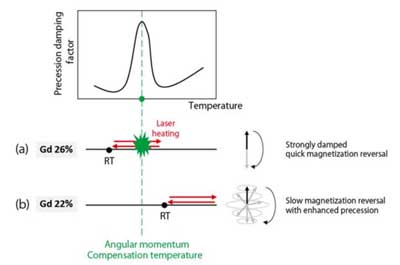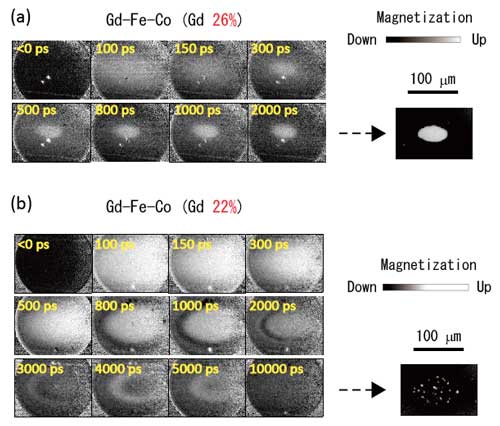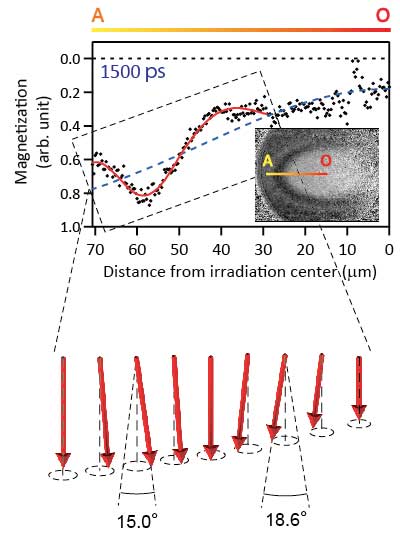| Posted: Sep 26, 2017 |
Physicists achieve rapid magnetic switching with lasers
(Nanowerk News) Making a magnet from a piece of iron and a coil or wire, or another magnet, is a simple experiment. An external electric or magnetic field can align groups of atoms in the iron over time so that they take on their own permanent magnetic field. A similar accelerated process stores information on computer hard disks. A special case of magnetism, known as ferrimagnetism, could enable even faster switching of magnetism, leading to massive improvements in the way computers handle information.
|
 |
| Figure.1. Schematic of magnetization reversals induced by laser pulses of Gd–Fe–Co thin films. The spin dynamics is known to differ depending on the angular momentum compensation temperature TA of the films. When the Gd content is 26% (TA>RT), smooth spin reversal with strong damping is expected. (Image: Osaka University)
|
|
Now, an international research group, led by Osaka University physicists, has provided new insight into how the composition of ferrimagnetic materials can affect their interactions with light. They recently reported their findings in Applied Physics Express ("Optical control of magnetization dynamics in Gd–Fe–Co films with different compositions").
|
|
“We know that laser pulses can reverse the magnetization in certain ferrimagnetic alloys, but light also affects other properties of the material,” coauthor Hidenori Fujiwara says. “To learn more about the interactions of the magnetism with light, we studied the spin dynamics of ferrimagnetic thin films containing different proportions of gadolinium.”
|
 |
| Figure.2. Time-dependent magnetic images of the (a)Gd26% and (b)Gd22% samples, respectively. In the Gd26% sample, clear spin reversal is observed. However, in the Gd22% sample, wave-like magnetization modulation propagated isotropically along the radial direction. (Image: Osaka University)
|
|
Ferrimagnetic materials can be thought of as a mixture of electrons spinning at different sites in the material. Some of the spins might cancel each other out, but a certain residual magnetization will remain. Firing an ultra-fast laser pulse at the material may completely flip the spin direction, reversing the magnetism, or may disrupt the spins, causing a kind of wobbling known as spin precession. The type of behavior shown strongly depends on the material’s temperature and composition.
|
|
The researchers used an advanced synchrotron measurement setup developed in their previous studies to show that slightly varying the composition of an alloy dramatically changed its response to the laser pulse. Slightly more gadolinium in the films led to flipping of the magnetic spin; slightly less led to spin precession at room temperature.
|
 |
| Figure.3. Spin distribution of Gd–Fe–Co film containing 22% of Gd at 1500 picoseconds after the laser pulse duration. A line profile of spin distribution (main graph), a magnetic image (inset image), and calculated distribution of spin directions (lower drawings) are shown. One can see propagating spin waves whose precession angle ranging 15–20 deg. (Image: Osaka University)
|
|
The researchers’ setup could also visualize the wave-like nature of the spin precession over a few nanoseconds following the laser pulse. They showed that the angle of precision, or the angle of the spin wobble, was the largest reported to date.
|
|
“These are complex systems with many different interacting properties, but we have extracted some clear relationships between the composition of a ferrimagnetic alloy and its magnetic interactions with light,” coauthor Akira Sekiyama says. “Understanding these behaviors is important from a fundamental physics standpoint, and essential for applying these material systems in advanced electronic devices.”
|



